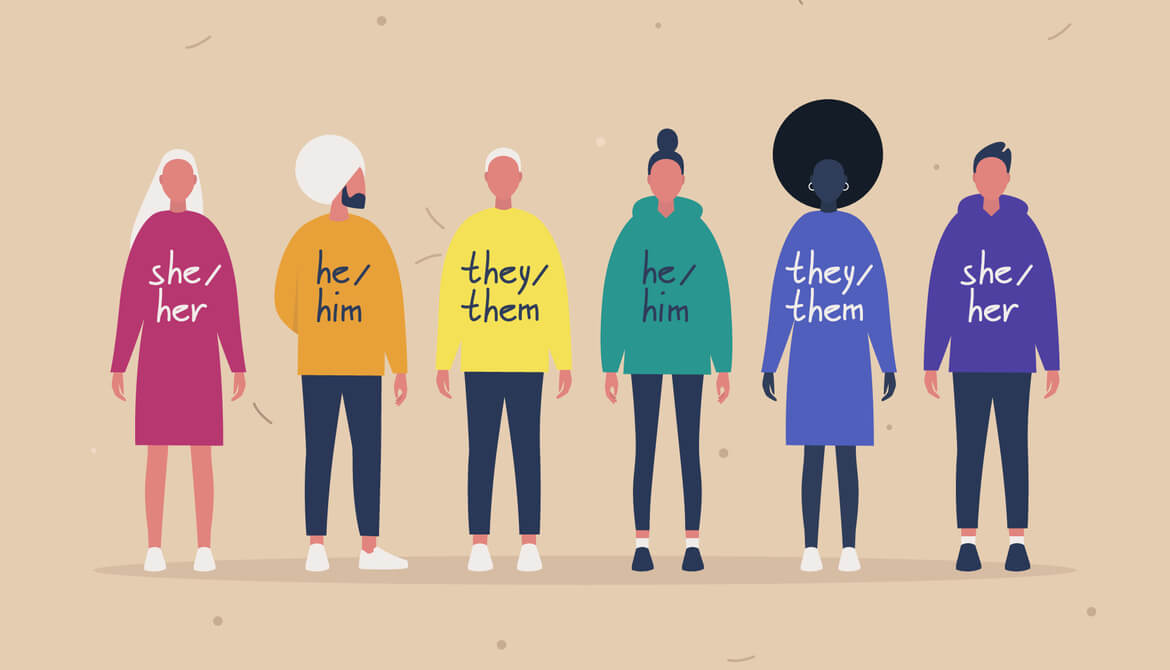7 minutes
Using these words well is important, especially to transgender and non-binary people in your organization and network.
There are many big, bold changes that organizations can make to advance their work in the diversity/equity/inclusion space. But in this article, we’re going to focus on really small changes that you can implement today that will make an immediate impact both inside and outside of your organization.
We’re going to talk about the importance of pronouns, specifically gender pronouns. These are the short words we use all day in conversation that most of us have the privilege of never thinking about: she, his, their, he, etc. These identifiers hold the place of our names, so efforts to use them correctly is important, especially to transgender and non-binary people.
Vocab Lesson
Before we dig into this topic, let’s start by clarifying some terms.
- Non-binary. Applies to people who do not identify as "male" or "female"
- Cisgender. Applies to people whose gender matches their assigned sex at birth
- Transgender (trans). Applies to people whose gender is different from their "assigned" sex at birth
- Genderqueer. Similar to "non-binary." Some people regard the term "queer" as offensive, while others embrace it
- Genderfluid. Applies to people whose gender identity changes over time
- Preferred pronouns. This has become a common way to inquire about someone’s pronouns. But, the word “preferred” implies that the use of these pronouns is a choice and that using them is optional when, just as with cisgender people, it is not. (Read more on this topic here) If you are unsure what pronouns someone uses, simply ask.
The Human Rights Campaign estimates that more than 2 million adults in the U.S. identify as transgender and three out of 10 people know someone who is trans. When we use these stats to look at the workplace, it’s highly likely that some of your employees and your customers are connected to the trans community. Transgender, non-binary and genderfluid people (among others) often use a chosen name and pronouns that are different than what were assigned to them at birth. When we recognize this, we show respect and remove uncertainty, social discomfort and even fear from an interaction.
Though the transgender community is gaining visibility, its members still face harassment, discrimination, violence and an ongoing battle for legal protection. The workplace is no different. The Human Rights Campaign reports that 27% of trans people have been fired, not hired, or denied a promotion due to their trans identity. A 2017 Newsweek article stated that 90% of transgender workers reported experiencing harassment at work, forcing many to hide their gender identity or quit all together. Those who stay in their roles are likely to receive lower wages and/or be denied promotions.
Individual Action
As with all diversity, equity, inclusion behavior changes, we’ll begin at the individual level. Below are examples of actions you can take today that will contribute to visibility for the transgender community and put those around you more at ease.
- Add your personal gender pronouns to your social media profiles. For cisgender people who present as their gender assigned at birth, this may seem obvious and unnecessary, but what you’re really doing is acknowledging that this is a safe space in which to be transparent about your identity. By taking this simple action, you’re creating a safer environment and raising awareness among your networks.
- Introduce yourself with your pronouns. (E.g., “Hi, I’m Heidi. My pronouns are she/they.”) Try this out at meetings, events or social gatherings or, given our current socially distanced situation, add your pronouns to your virtual meeting profile/name. Especially in new spaces with new acquaintances, modeling this behavior normalizes it for cisgender attendees and can put trans/non-binary guests at ease. Not a place for it on your conference/event name tag? Be proactive and add them.
- Use inclusive language. Another small change you can make is to use the word “partner” in place of “husband/wife, boyfriend” etc. Whether you’re referring to your own significant other or asking about someone else, you remove any assumption about gender identity and sexual orientation.
Workplace Changes
We know that workplaces benefit when employees can be their authentic selves and feel valued and accepted. There are several simple, low-cost steps you can take to help transgender staff and customers feel safe and welcome. Keep in mind that these items should be accompanied by education to ensure your entire team understands the importance of these actions. Equip your managers to answer questions about these changes and make it clear to all employees that it’s okay to ask. DEI is a journey and we’re all learning at a different pace.
- Include gender pronouns in email signatures and/or add them to workplace name tags. Just like the individual actions above, pronouns in email signatures signal to your co-workers, vendors, customers or potential new hires that you acknowledge the transgender community. This practice can also prevent you from misgendering people with gender-neutral names or with names you may not be familiar with.
- Include pronouns in workplace introductions. Welcoming a new team member to your first group meeting? Interviewing a job candidate? Add your pronouns when introducing yourself and invite your team to do the same. This is also a best practice for external/client meetings.
- Add a space for pronouns and correct name on your company intranet. Remember to invite your current employees to update their profiles with this information. It signals your intent that this will be the norm moving forward.
- Ensure your dress code is gender neutral. Make sure the language in your dress code avoids specifying types of clothing based on gender stereotypes. For example, “Women should wear skirts or dresses; men should wear suits.” Instead, spell out specific rules by article of clothing, not by gender. For example, "Employees should dress in business casual attire, which could include casual slacks and skirts, collared shirts, blouses, or sweaters. Inappropriate attire includes sportswear, jeans, and unkempt clothing … . "Simplifying your dress code language can empower employees and help build trust within your culture. GM CEO Mary Barra famously reduced the company’s former 10-page dress code down to two words: Dress appropriately.
Hiring Practices and Customer Interactions
Let job candidates and clients know that you’re a welcoming organization throughout the hiring/onboarding process. Transgender job seekers/clients and trans allies will be looking for inclusive language at each step, so make sure you’re including them in each touch point.
- Add a “pronouns” field to your job/membership application. She, he, ze, they or “name only” are the most common pronouns, but make sure you leave this option open as gender pronouns continue to evolve. Make sure all HR and hiring managers are using a candidate’s correct name and pronouns throughout the interview process and designate a space in your customer database for this information so that staff can do the same for your clients.
Inclusive Moves
Are you ready to take the right steps in your commitment to transgender inclusivity? The actions below are/will fast become expectations as visibility for the transgender community expands.
- Restroom and/or locker room facilities. Add gender-neutral restroom signage outside your existing single-use restrooms or locker room spaces. Nothing could be more basic than the ability to comfortably and safely use a restroom at work. Having gender-neutral restrooms available throughout your work/client-facing spaces can remove a huge burden for trans employees and clients.
- Join your local or national LGBTQ chamber of commerce. These local chambers can serve as helpful resources as you push for inclusivity in your organization and are a great way for transgender/allied job seekers and customers to find you.
- Recognize national transgender observances. March 31 is National Transgender Day of Visibility and November 13-19 is Transgender Awareness Week. Promote these observances organization-wide and use them as opportunities to spread awareness and reinforce your company’s commitment to inclusivity.
Making Mistakes
If you make a mistake or wrong assumption when referring to someone’s gender pronouns or name, just apologize, correct yourself and move on. The key is to make the effort and show that you understand the importance of getting it right. Make sure your team members understand how to handle mistakes so they can feel more confident in their interactions.
Including gender pronouns in your personal and professional interactions is a small change that can make a huge impact for trans and non-binary people in your circles and beyond. Inclusion is about being seen and appreciated for the unique lived experiences and identities you bring to workplace and personal relationships. Sharing your pronouns shows that you see the trans community and welcomes them to share their authentic selves in the spaces you help to build.
Heidi Duss (she/they) is the founder of Culturescape Consulting, a culture and inclusion consultancy based in Madison, Wisconsin. She is an award-winning LGBTQIA+ consultant with over 15 years of HR leadership experience. If you want to make the right moves towards a more inclusive workplace, let’s talk!
Register for a related learning event
will guide you through the importance of building knowledge and skills needed to create a welcoming and inclusive workplace for LGBTQ+ employees.
The online event will be held at noon Central time on June 8.






